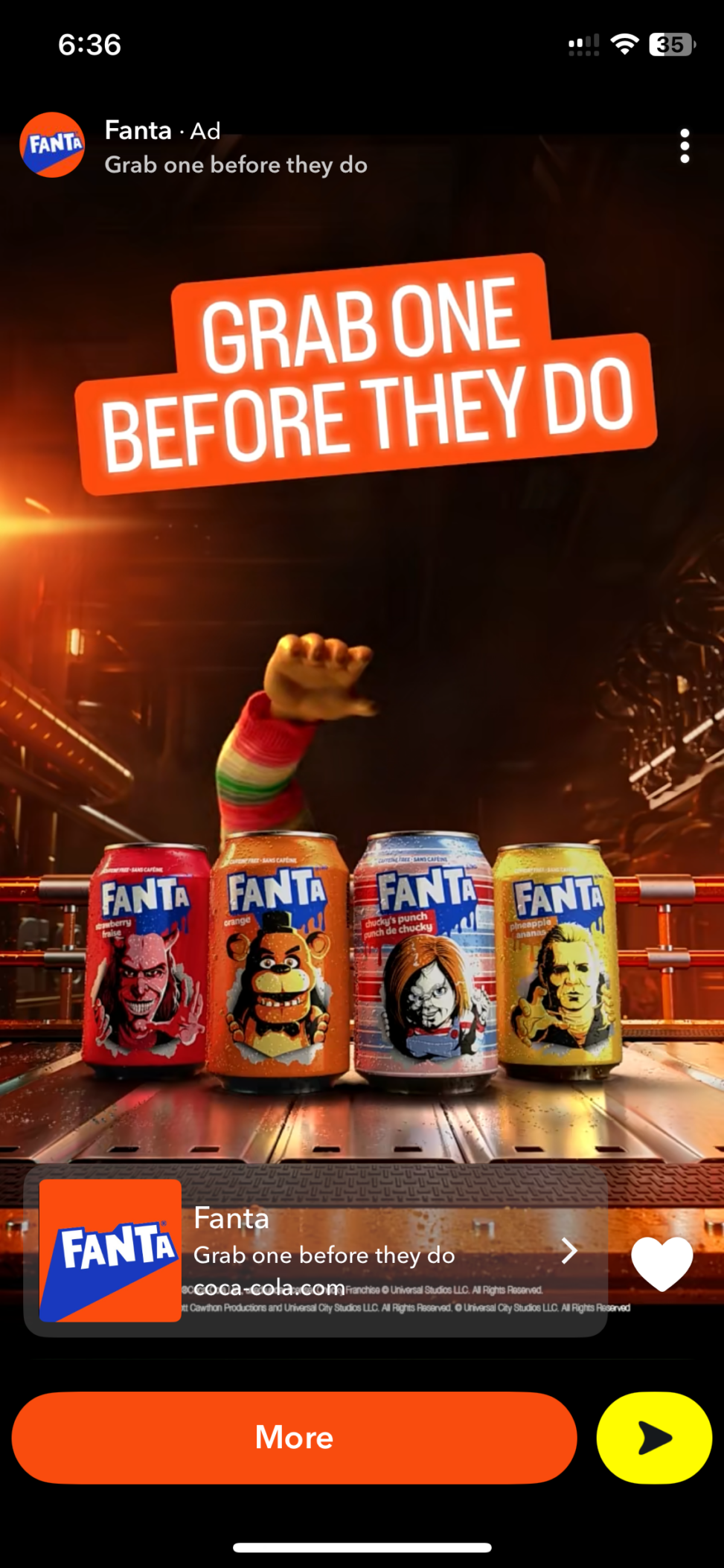The advertisement in question above is produced by Fanta, a brand owned by The Coca-Cola Company, as part of its 2025 Halloween marketing campaign. The product being sold is flavored soda, packaged in special edition Halloween-themed cans featuring pop culture horror characters such as Chucky who can be considered an icon in the world of “Horror”, Freddy (from Five Nights at Freddy’s), and others. The ad takes the form of a still digital image advertisement, likely designed for mobile platforms such as Instagram or TikTok, where younger consumers are a primary audience.
The image shows four cans of Fanta lined up on a metal conveyor belt, with a brightly lit orange background that immediately holds your attention due to it’s vibrancy. Hovering over the cans is a doll arm (Chucky’s) reaching out towards the drinks. The central slogan, “Grab one before they do,” is written in bold, neon-orange letters, catching the eye with an urgent tone. The campaign plays into the excitement of Halloween while using pop culture references to appeal to its audience.
The cans are arranged evenly spaced to highlight the range of flavors. Each can comes with vibrant colors—red, orange, blue, and yellow that not only stand out individually but also collectively mimic the seasonal colours associated with autumn and Halloween which gives in to extra depth and detail of this ad.
The main subject is clearly the Fanta cans, supported by the intrusive hand reaching from above. This hand, along with the catchphrase , introduces a sense of competition and scarcity, suggesting consumers must act quickly to secure the product. The background is blurred with mechanical factors, implying a factory-like setting that may symbolize mass production and a serious business portrayal.
The characters displayed on the cans themselves are highly recognizable cultural icons associated with horror and thrill. This reflects a strategic crossover between beverage marketing and entertainment media, merging Fanta with horror fandom. The use of well-defined, cartoon-styled images also appeals to a young demographic, many of whom engage with horror through gory video games and movies rather than purely adult horror genres.
The main message of this advertisement is scarcity-driven consumption as we have seen so many times before with our favorite snacks and drinks. Fanta positions its Halloween cans as highly desirable collectibles that must be secured before others do. The catch phrase “Grab one before they do” directly conveys urgency, competition, and exclusivity. This is a marketing strategy that taps into the psychology of FOMO (fear of missing out), a well-documented mechanism in consumer behavior (Przybylski et al., 2013).
Visually, the message is conveyed through:
• The reaching hand, which creates a sense of impending loss if the viewer does not act quickly.
• The bold, popping orange font which conveys intensity and energy associated with urgency.
• The horror character designs, which tap into cultural excitement around Halloween, pop culture fandom, and nostalgia.
The ad’s structure gives a mixture of consumer desire with entertainment culture, encouraging not only soda consumption but also brand affiliation with pop culture events. This makes the campaign less about the usually obvious qualities of the drink and more about being part of a collective seasonal experience.
The ad is largely effective in reaching its target audience: younger consumers, particularly Gen Z, who engage with seasonal promotions, enjoy limited-edition products, and are culturally aware in horror and gaming fandoms. The horror imagery is not excessively frightening but instead stylized, allowing it to be fun and approachable for a broad audience.
The advertisement convinces you through a visual and playful urgency that comes right at you. It appeals to the audience by making them feel that failing to purchase will exclude them from a cultural moment. However, the ad does not emphasize any social or ecological responsibility; it is purely consumption-driven. The effect on the viewer, therefore, is primarily emotional rather than ethical and it encourages excitement and passion of wants and needs.
Personally, while the ad is visually striking and effective in seasonal marketing, it can also criticized for perpetuating a hyper-consumerist narrative. It celebrates acquisition for the sake of exclusivity, with no acknowledgment of environmental concerns, which increasingly matter to young consumers (White, Habib, and Hardisty, 2019).
The Coca-Cola Company, which owns Fanta, is one of the world’s most recognizable beverage brands. Its practices, however, have been subject to critique, particularly concerning environmental sustainability. According to research by PepsiCo, Coca-Cola, and Nestlé have consistently ranked among the world’s top plastic polluters (Break Free From Plastic Report, 2022). Scholarly critiques argue that while Coca-Cola has introduced recycling initiatives, its single-use plastic dependency undermines claims of environmental responsibility (Véliz-Campos and Marín, 2020).
Fanta’s Halloween campaign does not claim social or ecological responsibility. Instead, it relies purely on cultural and emotional appeal. Unlike brands that link seasonal campaigns to charity or eco-friendly messaging, this campaign is silent on such issues, highlighting Coca-Cola’s general reluctance to foreground sustainability in celebratory promotions.
Coca-Cola has responded to consumer critiques in the past, pledging to collect and recycle a bottle for every one sold by 2030 (“World Without Waste” campaign). However, reports suggest progress has been limited, and many consumers and NGOs consider the company’s efforts as greenwashing rather than substantive reform (Véliz-Campos and Marín, 2020). Thus, while the Fanta Halloween campaign is successful in its design and messaging, it reflects Coca-Cola’s broader pattern of prioritizing short-term consumption appeal over long-term ecological responsibility.
Conclusion
The Fanta “Grab one before they do” Halloween campaign is an effective and eye-catching seasonal advertisement that leverages urgency, pop culture, and the spirit of Halloween to appeal to its target audience which is perfect for the season. Using bold design, iconic horror imagery, and scarcity-driven messaging, it successfully generates excitement and consumer desire. However, the absence of any socially or ecologically responsible framing underscores Coca-Cola’s ongoing critique as a brand that prioritizes consumption over sustainability. The campaign reveals the tension in modern advertising between cultural resonance and corporate responsibility, ultimately leaving Fanta’s promotion visually compelling but ethically limited.
Bibliography
Przybylski, Andrew K., Kou Murayama, Cody R. DeHaan, and Valerie Gladwell. “Motivational, Emotional, and Behavioral Correlates of Fear of Missing Out.” Computers in Human Behavior 29, no. 4 (2013): 1841–48. https://doi.org/10.1016/j.chb.2013.02.014.
Véliz-Campos, Mario, and Alejandra Marín. “Plastic Pollution and the Coca-Cola Company: Between Greenwashing and Environmental Responsibility.” Journal of Business Ethics 167, no. 2 (2020): 319–36. https://doi.org/10.1007/s10551-019-04179-7.
White, Katherine, Rishad Habib, and David J. Hardisty. “How to SHIFT Consumer Behaviors to Be More Sustainable: A Literature Review and Guiding Framework.” Journal of Marketing 83, no. 3 (2019): 22–49. https://doi.org/10.1177/0022242919825649.


Graesen Knighton
The critique and analysis of this advertisement is expertly done, as well as being easy to read and very well informed. Your main points of the Ad relying on FOMO, being reliant on high consumer consumption, leaning on the use of horror culture, the use of a hand reaching over to take the cans away from the consumer if they are not fast enough and using Halloween styled cans to convey exclusivity is a very good and impressive analysis of this advertisement. The discussion of the greenwashing of the coca cola brand is short but sweet as you bring up an eye-opening example of Coca-Cola having limited progress in there “recycle one can for every can bought” program. Another good piece of writing critiquing Coca-Cola’s greenwashing is that they have been among the world leaders in plastic pollution. Your use of scholarly sources is good particularly when you bring up key points in both your Advertisement analysis and greenwashing critique your sources are there to back up and support that idea. Your sources, however, are not in Chicago style format as intended in the Assignment. (this might be because of the copy paste from word to Splot technique not working and you might’ve had to improvise) To conclude I think you could’ve dug deeper into Coca-Cola’s greenwashing as there is most likely more to be found regarding that company.